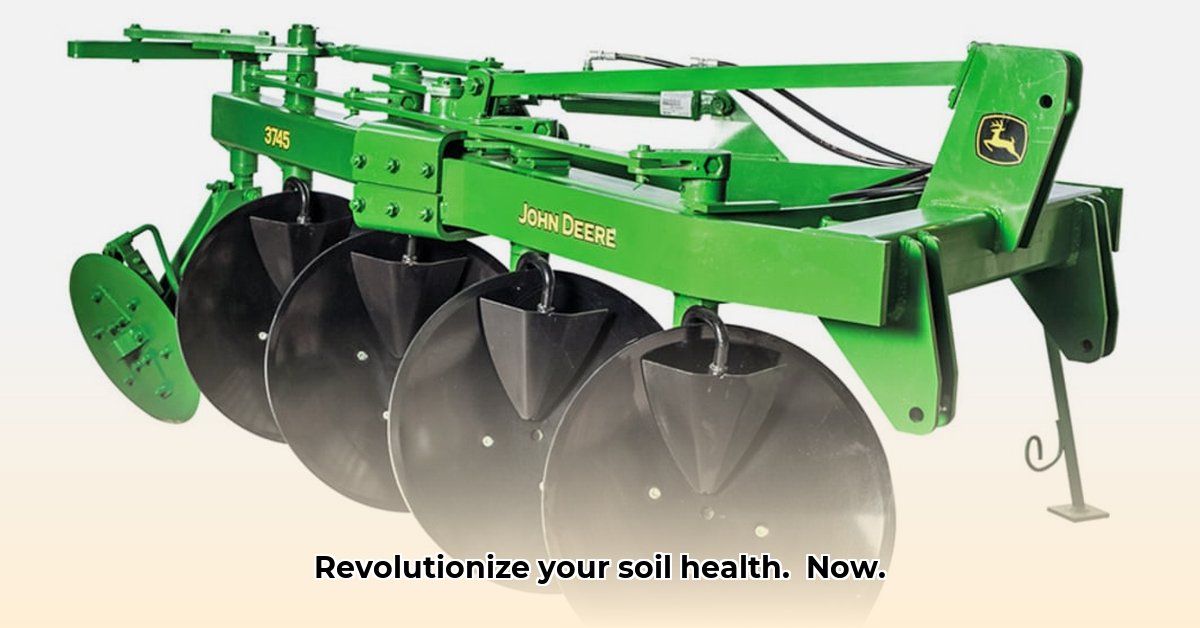
Understanding Your Disc Plow Tractor and Its Capabilities
Your disc plow is a precision tool for soil tillage, cutting, mixing, and leveling soil to prepare it for planting. To maximize its effectiveness, understand its capabilities and limitations. Think of it as a finely tuned engine – proper handling ensures optimal performance. A disc plow's effectiveness depends heavily on soil type and conditions. For more information on tractor sizing, check out this helpful guide on tractor sizing.
The Advantages of Disc Plowing: Improving Soil Health and Yields
Disc plowing offers several key advantages for improving soil health and increasing yields:
Enhanced Soil Structure: Improved soil structure facilitates better water absorption and nutrient uptake, providing your crops with essential resources for optimal growth. This leads to more robust, healthier plants.
Effective Weed Control: By burying weed seeds deeper, disc plowing reduces weed growth and minimizes the need for herbicides, promoting environmentally friendly practices.
Organic Matter Incorporation: Disc plowing mixes crop residue back into the soil, adding valuable organic matter and enriching soil fertility. This acts as a natural fertilizer.
Long-Term Cost Savings: Reduced herbicide use and increased yields translate to significant long-term cost savings, promoting sustainable and profitable farming.
Potential Drawbacks of Disc Plowing and Mitigation Strategies
While beneficial, disc plowing presents some potential drawbacks that require careful management:
| Potential Problem | Mitigation Strategies |
|---|---|
| Soil Compaction | Adjust plowing depth and speed; consider alternative tillage methods like no-till or reduced tillage for sensitive soils. |
| Increased Fuel Consumption | Maintain equipment regularly; ensure your tractor has sufficient horsepower; avoid unnecessary passes. |
| Residue Management Challenges | Use appropriate disc plow configurations and implement effective crop residue management strategies before and after plowing. |
| Potential Soil Erosion | Plow along the land contours; consider planting cover crops to prevent erosion. |
A Step-by-Step Guide to Effective Disc Plowing
Mastering disc plowing involves a systematic approach. Follow these steps for optimal results:
Soil Analysis: Assess your soil type and consider professional soil testing to determine nutrient levels and overall health. This informs your plowing strategy and depth.
Equipment Matching: Ensure your tractor possesses sufficient horsepower for efficient plowing. Underpowered tractors can lead to compaction; over-powered tractors may be inefficient.
Precise Depth Control: Adjust plowing depth appropriately. Too shallow prevents adequate soil mixing; too deep risks compaction and soil structure damage.
Optimized Speed: Find the optimal plowing speed – too fast compacts the soil; too slow decreases efficiency. Experiment to determine the sweet spot for your conditions.
Residue Management: Determine the optimal amount of residue to leave on the field. Some residue is beneficial, enriching the soil; excessive residue can clog equipment.
Precision Technology: Utilize GPS guidance systems for precision plowing, reducing overlap and saving fuel while minimizing soil disturbance.
Long-Term Soil Health: Sustainable Farming Practices
Building and maintaining healthy soil is a continuous process. Regularly monitor soil health using indicators such as organic matter content and water infiltration rates. Consider integrating no-till or reduced-till farming techniques into your crop rotation to enhance long-term soil health. "Continuous disc plowing can lead to soil degradation," warns Dr. Emily Carter, Soil Scientist at the University of California, Davis. "Consider alternative approaches for long-term soil sustainability."
Choosing the Right Disc Plow for Your Needs
Selecting the appropriate disc plow involves several key considerations:
Working Width: Choose a working width that balances efficiency and the size of your fields.
Tractor Compatibility: Ensure compatibility with your tractor's horsepower and other specifications.
Special Features: Consider additional features like adjustable gangs or hydraulic depth control for enhanced precision.
Consult equipment suppliers for guidance on selecting a suitable model that meets your farming needs and budget.
Minimizing Soil Compaction: Sustainable Disc Plow Usage
Soil compaction severely reduces crop yields by hindering water infiltration, root growth, and nutrient uptake. While disc plows are beneficial, improper use can exacerbate compaction. Sustainable practices minimize these negative impacts. "Soil compaction reduces yields by 15-20% on average," states Dr. John Miller, Agricultural Engineer at Purdue University.
Strategies for Minimizing Compaction:
Optimal Timing: Avoid plowing excessively wet soil.
Controlled Depth: Adjust depth based on soil type and desired tillage. Shallow passes are often preferable.
Reduced Passes: Minimize passes to reduce soil disturbance. Consider no-till or reduced tillage.
Appropriate Equipment: Use disc plows designed to minimize compaction, such as those with concave discs or reduced-disturbance blades.
Controlled Traffic: Minimize wheel traffic by planning field operations strategically and using wider tires.
Soil Health Improvements: Enhance soil structure using crop rotation, cover cropping, and organic matter additions.
Conclusion: Sustainable Success Through Optimized Disc Plowing
Effective disc plowing involves more than just completing the task; it’s about building a robust foundation for future harvests. By following these guidelines, you can maximize benefits, creating a sustainable and thriving farm operation. Remember, healthy soil is the cornerstone of successful and profitable agriculture.